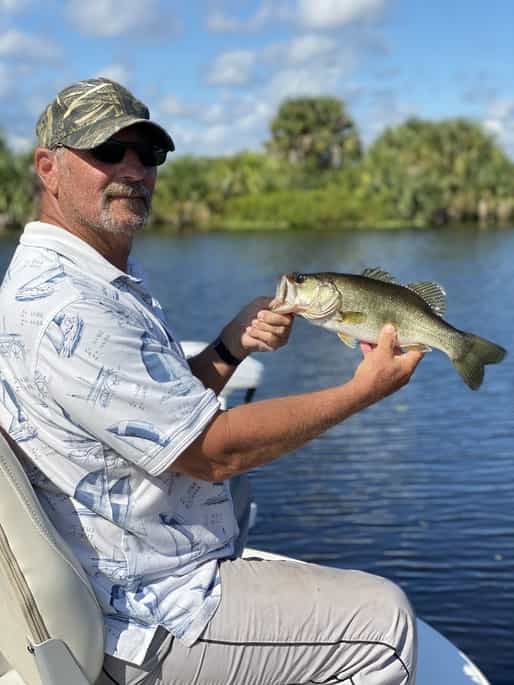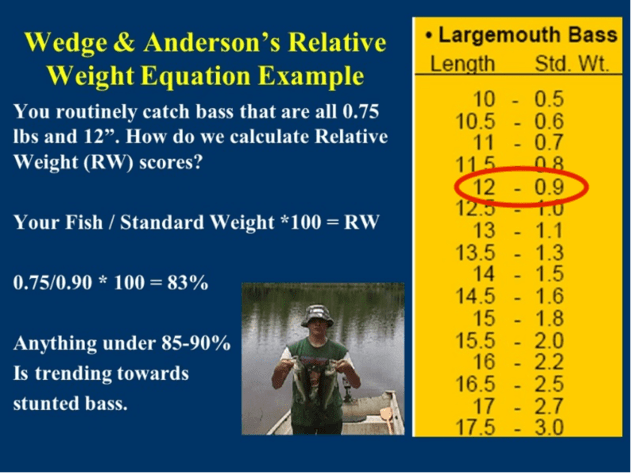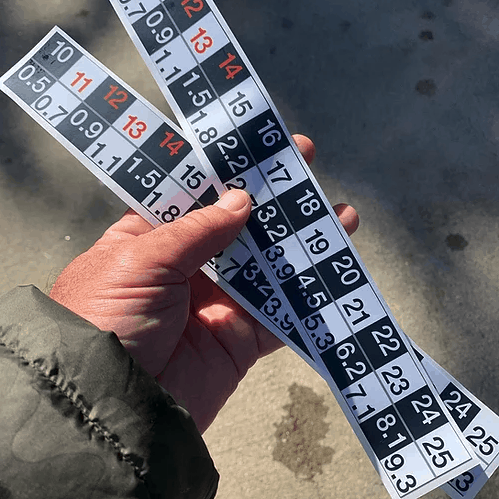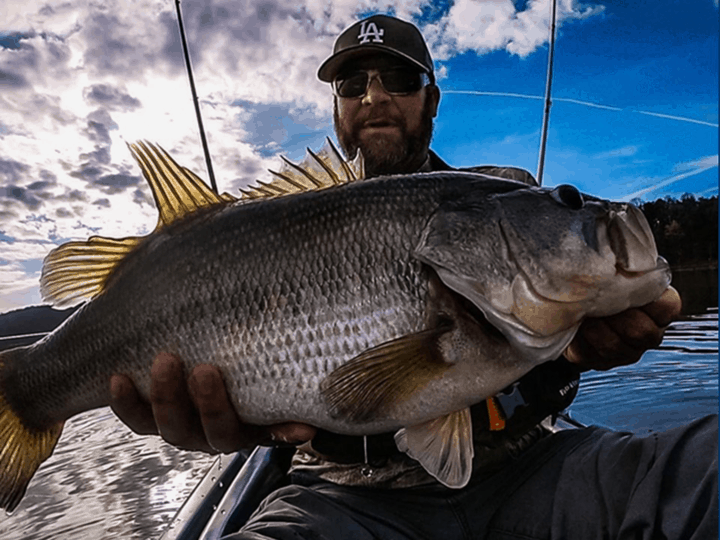All over the country, there are countless small ponds that provide hours of entertainment and tranquility for anglers of all backgrounds.
Heck, some of my fondest memories are fishing in small neighborhood ponds as a kid…
But, when it comes to pond fishing, there is a common problem: Lots of small bass!
In this article, I’ll dive into the details on why this happens, how to identify the problem and correct it moving forward.
The good news is that there is a solution!
Table of Contents
Why Do I Only Have Small Bass In My Pond?
The reason bass are often small in ponds & private lakes is due to a poor forage base that is lacking quality-sized prey. This issue begins on the microscopic level, and in turn, is directly correlated with the pressure applied by bass as the predator species.

In layman’s terms: Bass often get stunted in ponds due to not having enough forage (food) to support a growing population. The result is a lot of small bass and an imbalanced system.
Many folks attempt to solve this problem by adding in more bluegill, shad, shiners, or other baitfish…but the problem begins on the microscopic level.
Identifying the problem
The first thing we need to dig into is the food web in a pond or lake. Bass eat bluegill and shad, they love crawfish, trout are tasty, and if you get enough of them, you should have big bass…right?
Not exactly.
It all comes down to what bass are eating, and the energy it takes to catch and consume it. The base of your bass’s food chain lies in the productivity of the water in which it lives. Where does that come from you might ask?
Jump in your small boat and explore your pond…pay attention to what you see. The answer is to look to the watershed, as well as the management of the water quality within the pond.
Every body of water has a set carrying capacity, which is driven by the fertility of the drainage area of the pond.
This productivity can be elevated in your pond through effective fertilization and liming, through feeding, or through all of the above, but the true key lies in harvest manipulation.
This means you strategically decide which bass need to be removed, and in what quantities to help you achieve your goals. It’s all tied to a relative weight score which we’ll discuss a little later.
You see your job is to look at your foundation. To you, that’s probably bass genetics and forage fish…but think smaller, much smaller!
Ultimately you need to be looking at maximizing phytoplankton production. Phytoplankton are microscopic plants that produce energy and oxygen from nitrogen, phosphorus, and sunlight.
Phytoplankton feed zooplankton, which in turn feed aquatic insects, and ultimately forage fishes. Largemouth Bass need adequate and renewable forage fish to grow to their potential.
Therefore, the size distribution of forage fishes is key to determining whether you catch small bass or big bass.
See Also: 5 Reasons Why Your Pond Smells Fishy

Therefore, the size distribution of forage fishes is key to determining whether you catch small bass or big bass.
Understanding What Bass Eat (forage fish)
Forage fishes come in a variety of shapes, sizes, and species. All too often I see anglers and consultants look to stock shad to save the day.
Shad are a nice option, but always remember, they’re eating the same phytoplankton, which is a fixed resource in your pond.
It doesn’t matter if you have shad, bluegill, trout, or crawfish.
What matters is their size and relative abundance. Too much, or too little and the bass can starve, or more commonly, stunt their growth due to inadequately sized forage.
Imagine you have a pizza for some hungry teenagers. One slice per kid ain’t gonna cut it.
A skinny kid just trying to get by for a few hours, with a high metabolism, probably wants a few slices of pizza. A kid trying to purposely gain weight might eat the entire pizza. A college football lineman might eat 2-3 pizzas. Bass are the same way!

What happens in ponds and small lakes is that the bass are typically very successful in their reproduction.
This means more Bass and having so many mouths to feed puts pressure on the forage base.
Forage fish are consumed quickly until the only thing that is typically left are adult bluegill or large gizzard shad and new reproduction (tiny baby fish). That’s like having people over for dinner and serving baby carrots or whole chickens.
Not exactly ideal for everyone right?
That newly hatched bluegill is equivalent to giving that college football lineman a skittle every time he runs a 40-yard dash. He’s not going to like you, and neither will a big adult bass. He wants a whole pizza!
You May Also Like: Coppernose Bluegill…What’s All The Fuss?
So the key is to make sure your forage fish have enough to eat by ensuring they too have enough food. This can be done through watershed enhancement and selected harvest.
For example, you can harvest bass at an appropriate rate so that fewer bass remain. This allows each forage fish to survive a little longer, so that they get to a nice 3-5” size. This is due to less predation, providing a better meal per unit of effort for the bass.
In other words, by harvesting more bass out of your pond you are going to reduce the amount of predation and allow the forage base (aka food source) to grow to a larger size, which is then going to contribute to larger growing bass.
Understanding Bass Size & Weight Ratios
To properly evaluate your lake or pond, you need to understand the relative weight of your bass.
Relative weight is a term that describes how fat or skinny your bass is at a given length.
For example, a bass with a relative weight score of 100% is getting adequate food. Bass in a pond full of “small bass” typically have a relative weight in the 60% -70% range. Bass in my consultant buddy’s trophy lake often have a relative weight of 125% or more.
You May Also Like: Carp vs Bass…Friendly Neighbors or Harmful To Fishing?
Calculating relative weight is an easy math problem. Catch a bass, and measure the length and take the weight (I recommend using a bump board to get an accurate measurement)..
Let’s say for example you catch a bass that is 12” long, with a weight of 0.75 lbs. Now, refer to a Largemouth Bass Standard Weight Chart, and find a 12-inch bass.

As we can see, the standard weight is 0.9 lbs. Divide the weight of your bass (0.75lbs) by the standard weight (0.9 lbs). This will give you a Relative Weight percentage of .83, or 83%.
This would be considered poor and trending toward a stunted bass. That means your 0.75 lb bass is underweight. It needs better forage to achieve your goal for bigger bass!
By understanding the relative weight of bass in your pond using a standard weight chart you can begin to see trends in the size and health of your bass. This information can be very useful when managing your lake or pond!

Learn more about the relative weight of bass here.
So How Do I Grow Bigger Bass In My Pond?
Assuming that you have a balanced watershed, and the proper forage base for your fish, the key to growing bigger bass is through Harvest Manipulation.
That is strategically deciding which sized bass and how many to harvest from your pond or lake.
Your first thought may be to remove as many bass as possible, which in theory would work, but you could also decimate the fishery. The real key is to select the right kinds of bass to remove and to protect others.
For example, In most small ponds you could suggest removing all of the bass under 12” during the first year.
In each subsequent year, you might notice some improvement and move that scale up a bit. The more aggressive you become with the harvest, the lower your catch rates will be, so keep this in mind.
Each year you should begin to see some 14-15” fish emerge, followed by 16-18”, and someday 20”+.
Each spring you should be able to up the size for cull bass, until your population becomes more balanced, and trophies become more common.
Growing big bass takes time and focus, which is why many fisheries biologists often recommend starting over.
A typical restart situation has you catching 3-5+ pound bass in 2-3 years, often 8+ pound bass in 4-6 years consistently. Either way, you’ll have to learn how to harvest effectively if you intend to grow trophy bass.
Conclusion

As you can see, the reason for having small bass is a bit more than not having enough food. When you have small bass, you still have the same productivity fueling your forage base.
Growing big bass is all about managing the size of your bass through effective harvest, and the size of your forage species through effective watershed management. Maintaining proper balance and collecting data is key.
Having a private pond or lake full of big healthy bass is a wonderful hobby and a great source of fun for all ages. With a little work, persistent effort, and effective management it’s very possible to grow big bass!
You May Also Like: Are Largemouth Bass Good To Eat, And Should You Keep Them?
If you haven’t guessed yet, I love fishing and everything about it!
To learn more about why I started Panfish Nation, visit the About page and follow along on Social Media:


Download a copy of my FREE Lure Color Selection Chart & Knot Guide!
Stay up to date with fishing reports, tackle reviews, industry news, and much more! We respect your privacy, unsubscribe at any time.
Additional Resources
Want to learn more about managing your lake or pond for big Largemouth Bass? Check out this Interview with Fish Biologist Shan O’Gorman for in-depth analysis:
